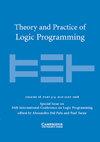Determining Action Reversibility in STRIPS Using Answer Set and Epistemic Logic Programming
IF 1.1
2区 数学
Q3 COMPUTER SCIENCE, SOFTWARE ENGINEERING
引用次数: 1
Abstract
Abstract In the context of planning and reasoning about actions and change, we call an action reversible when its effects can be reverted by applying other actions, returning to the original state. Renewed interest in this area has led to several results in the context of the PDDL language, widely used for describing planning tasks. In this paper, we propose several solutions to the computational problem of deciding the reversibility of an action. In particular, we leverage an existing translation from PDDL to Answer Set Programming (ASP), and then use several different encodings to tackle the problem of action reversibility for the STRIPS fragment of PDDL. For these, we use ASP, as well as Epistemic Logic Programming (ELP), an extension of ASP with epistemic operators, and compare and contrast their strengths and weaknesses.用答案集和认识逻辑程序确定STRIPS中的动作可逆性
在对行动和变化进行规划和推理的背景下,当一个行动的效果可以通过应用其他行动而恢复到原来的状态时,我们称之为可逆的行动。在PDDL语言(广泛用于描述规划任务)的上下文中,对这一领域重新燃起的兴趣导致了几个结果。在本文中,我们提出了决定一个动作可逆性的计算问题的几种解法。特别地,我们利用从PDDL到答案集编程(ASP)的现有翻译,然后使用几种不同的编码来解决PDDL的条带片段的动作可逆性问题。对于这些问题,我们使用ASP,以及带有认知运算符的ASP扩展的认知逻辑编程(ELP),并比较和对比它们的优缺点。
本文章由计算机程序翻译,如有差异,请以英文原文为准。
求助全文
约1分钟内获得全文
求助全文
来源期刊

Theory and Practice of Logic Programming
工程技术-计算机:理论方法
CiteScore
4.50
自引率
21.40%
发文量
40
审稿时长
>12 weeks
期刊介绍:
Theory and Practice of Logic Programming emphasises both the theory and practice of logic programming. Logic programming applies to all areas of artificial intelligence and computer science and is fundamental to them. Among the topics covered are AI applications that use logic programming, logic programming methodologies, specification, analysis and verification of systems, inductive logic programming, multi-relational data mining, natural language processing, knowledge representation, non-monotonic reasoning, semantic web reasoning, databases, implementations and architectures and constraint logic programming.
 求助内容:
求助内容: 应助结果提醒方式:
应助结果提醒方式:


